Traditional Scottish Shortbread
This post may contain affiliate links. See my disclosure policy.
This traditional Scottish Shortbread recipe creates those perfectly crumbly, irresistibly buttery, and wonderfully delicious shortbread biscuits that have been a year-round favorite treat for centuries. It’s made with just 3 staple ingredients but the flavor and texture is unforgettable!
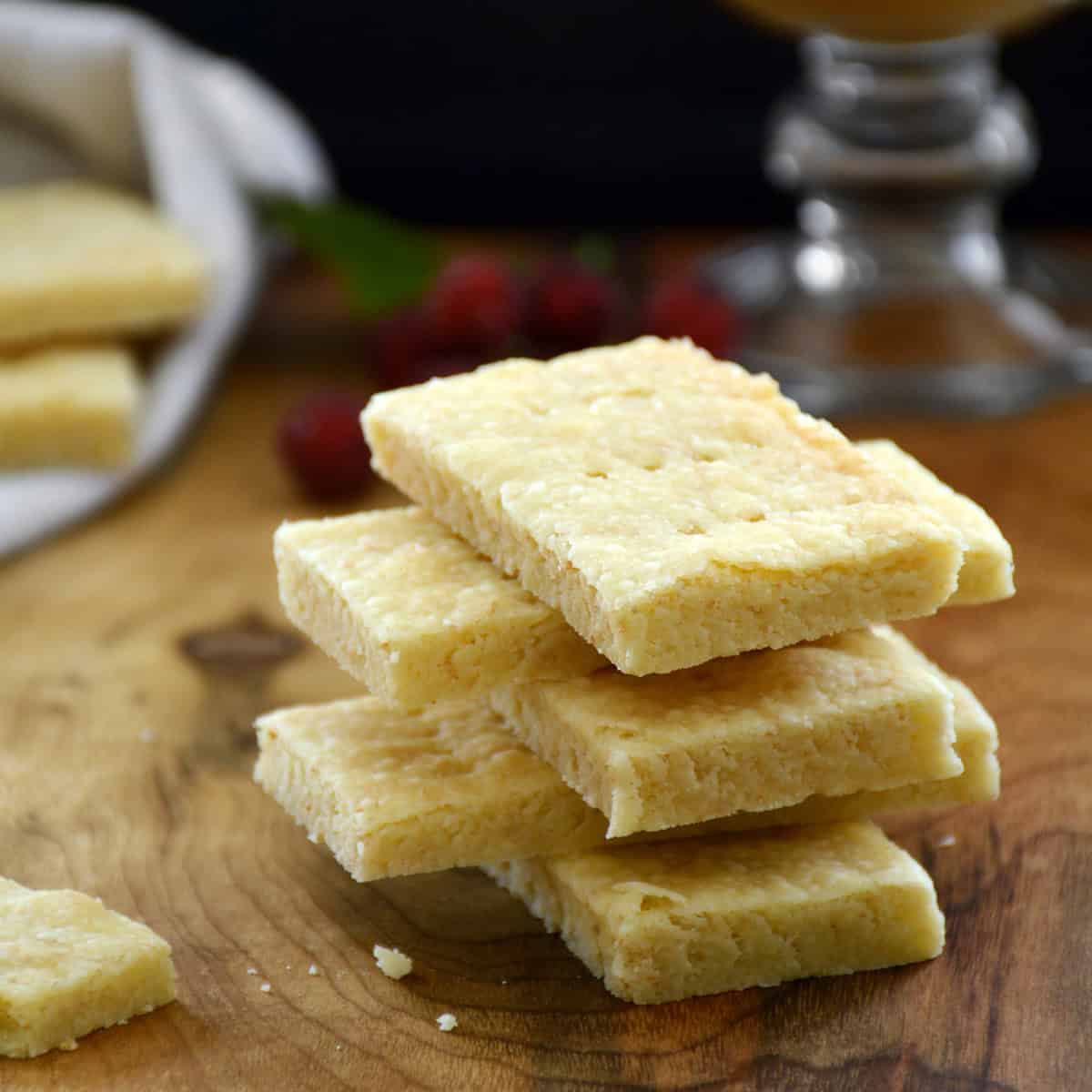
What is Shortbread?
Shortbread is as basic and simple as a cookie (biscuit) can get. But it’s also divinely delicious. And for that reason shortbread has been a favorite throughout the UK for hundreds of years.
The origin of shortbread goes back to somewhere around the 12th century when it was originally made from leftover bread-making dough that was left to dry out and harden into “biscuit bread.” Over time butter replaced the yeast and biscuit bread evolved into shortbread. The term “short” refers to the crumbly texture from the large quantity of butter. Butter was a luxury item and so shortbread was enjoyed only on special occasions and, of course, by the nobles and royals.

The more refined version of shortbread as we know it today is attributed to Scotland, in particular to Mary, Queen of Scots in the 16th century. She was particularly fond of what was known as Petticoat Tails, which was a thin shortbread baked in a large circle and cut into triangular segments. In her day the shortbread was commonly flavored with caraway seeds, which were all the rage in British baking for several centuries. In fact, the earliest published shortbread recipes from the 18th century were more elaborate than the standard shortbread today: They were baked with candied citrus peels and garnished with caraway comfits.
Traditionally Scottish shortbread is baked in either a rectangular or square slab and cut into fingers, as individual round biscuits, or in one large circle and cut into triangles. But you can cut them any shape you like and also use cookie stamps. I have these cookie stamps, these ones, and these ones and love them all – excellent quality.

Scottish Shortbread Ingredients
We’re making Scottish shortbread the traditional way with just 3 ingredients: Flour, Sugar and Butter. Well, and a tiny pinch of salt, too. Nothing else is needed, no fancy ingredients, no flavor enhancers. The key to a good Scottish shortbread is the quality of the butter. That is what flavors the shortbread and the shortbread is only as good as the butter.
I’ve read a few claims that “traditional” Scottish shortbread is made with farola, which is a fine flour milled from durum wheat. But the oldest recipes I’ve researched do not, so this “tradition” may be a later/more contemporary one. Likewise some recipes call for powdered/confectioner’s sugar as well as rice flour; neither of these are traditional and should be avoided if you’re goal is to make authentic Scottish shortbread.
Another key to making Scottish shortbread is to use caster sugar. Not regular granulated sugar. Not powdered/confectioner’s sugar. Caster sugar is very fine granulated sugar. Caster sugar is commonly used in British baking and it’s an all-around smarter choice than granulated. The reason is that the sugar crystals in granulated sugar are much larger and take longer to dissolve during baking and may not dissolve completely. Caster sugar dissolves more rapidly leaving a finer texture to the baked good. You can buy caster sugar in the store or very simply make your own buy pulsing granulated sugar in a food processor or blender until it is ground more finely.

Scottish Shortbread Variations
In addition to the three base ingredients of flour, sugar and butter, there are a number of add-ins you can include to flavor your shortbread. Classic options include candied ginger, candied orange peel, dried cranberries or cherries, nuts, chocolate chunks, rosemary, lavender, and you can also dip or drizzle the shortbread biscuits with chocolate.

This Scottish Shortbread recipe is very simple and very easy to make and once you’ve made it yourself there will be no need to buy it again! Before we get started, if you want to take your shortbread to the next several flavor levels, try my traditional Scottish Millionaire’s Shortbread. With layers of shortbread, caramel and chocolate it is the ultimate indulgence! (Incidentally, it’s what my son requests every year for his birthday!)
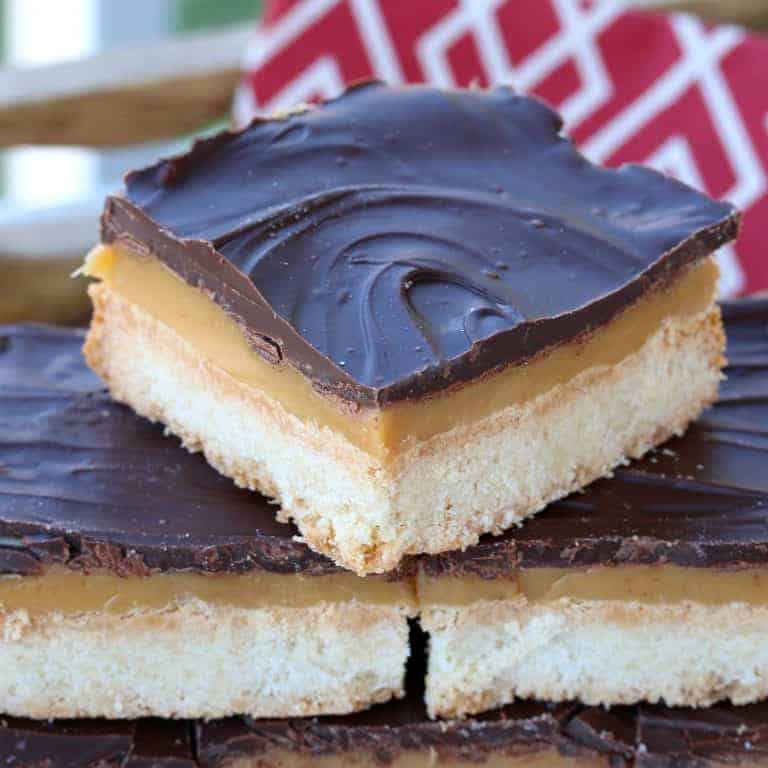
Scottish Shortbread Recipe
Let’s get started!
You can either buy caster sugar (it’s overpriced) or make you’re own, which is what I do. Super easy: Just put the sugar in a blender or coffee/spice grinder and pulse until it’s very fine.

Place the flour, butter, caster sugar and salt in a food processor and pulse until it’s combined and looks like coarse breadcrumbs but is soft and pliable and comes together in a dough when you press it together between your fingers. If it’s too dry and crumbly it needs to be pulsed a bit longer.
At this point stir in any add-ins if using (candied ginger, candied citrus peel, herbs, nuts, etc.)
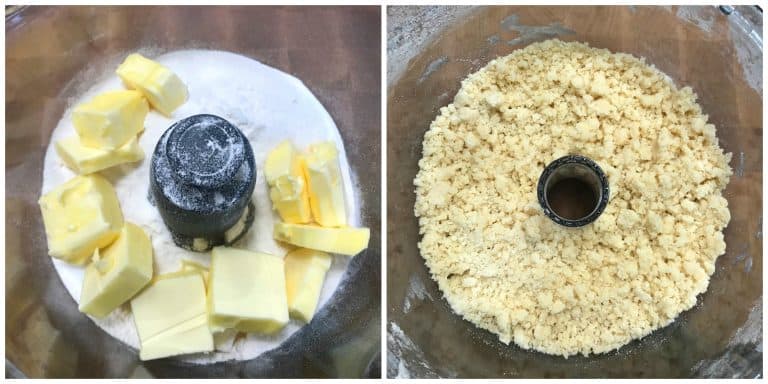
Pour the mixture into a greased 8×8 inch (shortbread roughly 3/4 inch thick) or a 9×9 inch (shortbread about 1/2 inch thick) baking pan. You can also use a round cake pan. Use your fingers and hands to firmly press down the mixture.

Prick the shortbread with the tines of a fork, creating rows. You can also run a knife between each row of fork tines to make cutting the shortbread easier after it’s baked. Another option is to prick the shortbread with a fork immediately after it is done baking while it is still warm; this way the holes will be more pronounced as they have a tendency to close during baking.
Preheat the oven to 350 degrees F. Place the shortbread on the middle rack and bake for 30-35 minutes or until light golden and firm. Remove from oven and sprinkle lightly with caster sugar or granulated sugar. Let cool. Cut and serve.
Store the shortbread in an airtight container for up to several weeks. Its flavor and texture improves over time.
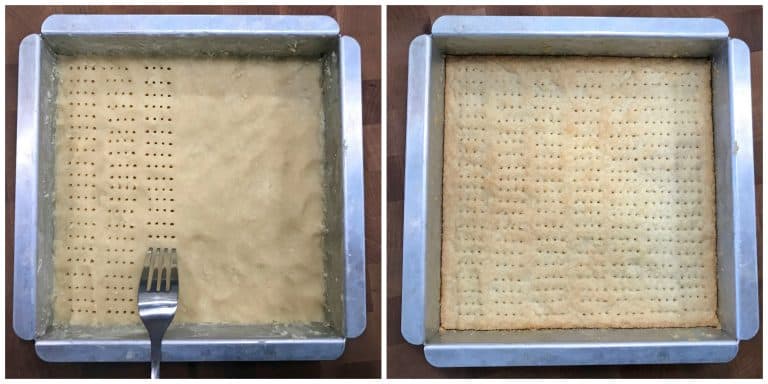
Storage Tips
Shortbread has a low moisture content and so it does best when it’s stored in an airtight container. Cool, dry conditions are optimal to enable the shortbread to retain some crisp without becoming stale. Stored this way it will keep for a few weeks. If you plan on keeping it longer it can also be frozen. To do that, place some parchment paper between the shortbread biscuits to prevent them from sticking to each other. Freeze them in freezer containers or ziplock freezer bags and let them thaw at room temp when you’re ready to eat them. They can be frozen for up to 3 months.
Enjoy!
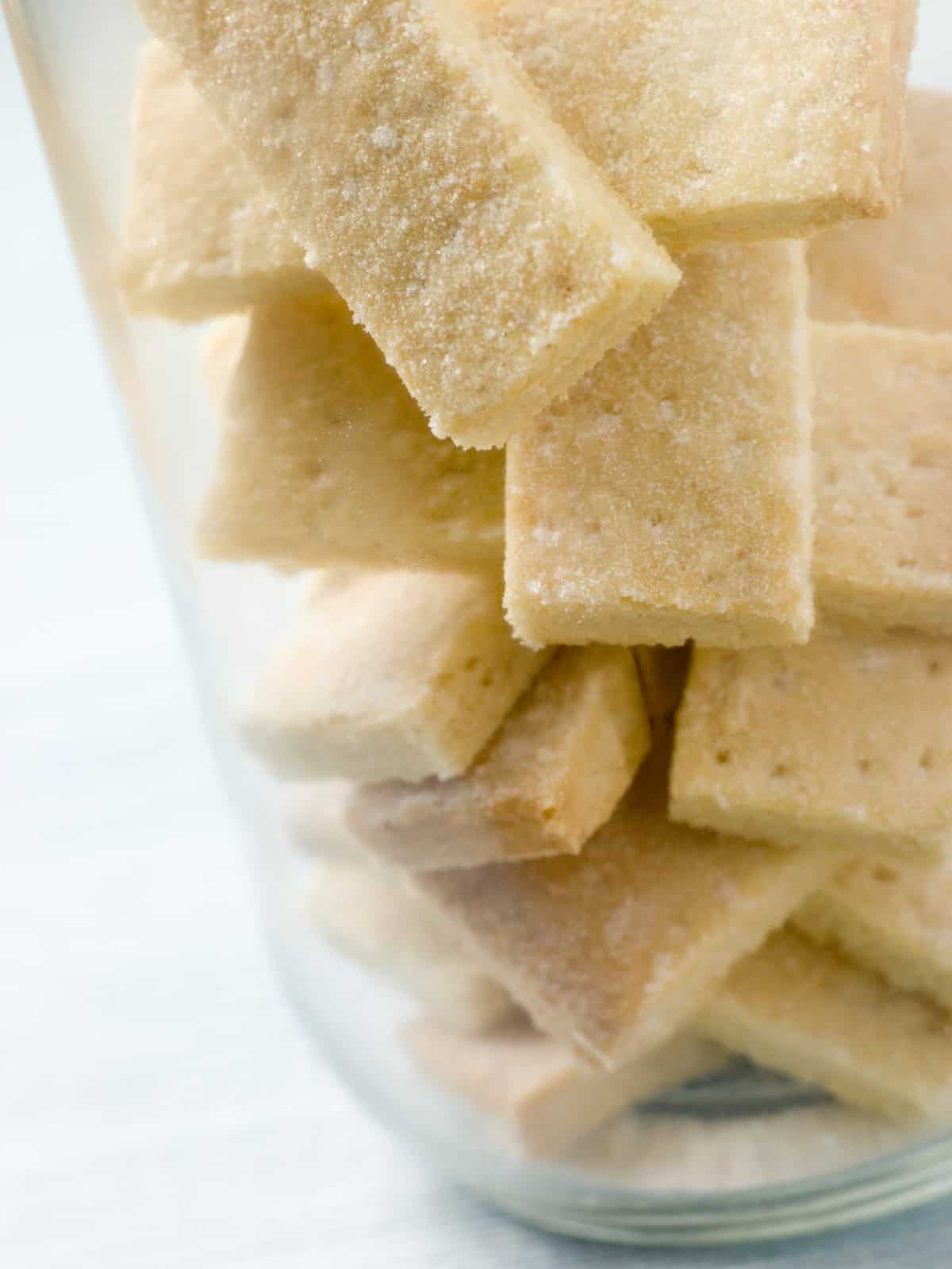
For more traditional British treats try my:
- Treacle Tart
- Sticky Toffee Pudding
- Spotted Dick
- Chelsea Buns
- Lardy Cake
- Eccles Cakes
- Chelsea Buns
- Cornish Fairings
- Hot Cross Buns
- Easter Biscuits
- Parkin
- Bara Brith
- Barmbrack
- Mincemeat
- Mince Pies
- Victoria Sponge Cake
Save This Recipe
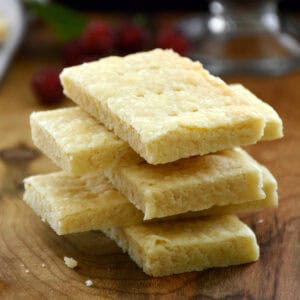
Traditional Scottish Shortbread
Equipment
- Cookie stamps (optional)
Ingredients
- 2 1/2 cups all-purpose flour
- 1 cup quality unsalted butter , cubed and softened at room temperature (the better the butter, the better the shortbread)
- 1/2 cup caster sugar , or "baker's sugar" in the U.S. (if you can't find it simply pulse granulated sugar in a blender until very fine. Do NOT use powdered sugar)
- 1/2 teaspoon salt
- Optional Add-Ins:
- Homemade Candied Ginger (click link for recipe)
- Homemade Candied Citrus Peel (click link for recipe)
- Other options include nuts, fresh herbs, dried cranberries, etc.
Instructions
- Preheat the oven to 350 degrees F. Butter a 8×8 or 9×9 inch square baking pan. You can also use a round cake can and cut the shortbread into triangles.
- Place the flour, butter, caster sugar and salt in a food processor and pulse until it's combined and looks like coarse breadcrumbs but is soft and pliable and comes together in a dough when you press it together between your fingers. If it's too dry and crumbly it needs to be pulsed a bit longer. (If using any add-ins, stir them in at this point.)Pour the mixture into the greased baking pan. Use your fingers and hands to firmly press down the mixture. Note: If the mixture is too dry to work with, including pricking with a fork (see below), then it was not pulsed long enough in the food processor. Prick the shortbread with the tines of a fork, creating rows. You can also like run a knife between each row of fork tines to make cutting the shortbread easier after it's baked. Another option is to prick the shortbread with a fork immediately after it is done baking while it is still warm; this way the holes will be more pronounced as they have a tendency to close during baking.
- Place the shortbread on the middle rack and bake for 30-35 minutes or until light golden and firm. Remove from the oven and sprinkle lightly with caster sugar or granulated sugar. Let cool. Cut and serve.Store the shortbread in an airtight container in a cool place (not the fridge) for up to several weeks. Its flavor and texture improves over time.
Nutrition
Originally published on The Daring Gourmet March 10, 2019



















I’ve made dozens of batches. It is THE best recipe I’ve tried. I’ve love it toooo well and freezes like a dream
I tried this a few times and every time it comes looking like lancashire hotpot. What am I doing wrong?
I have tried this recipe twice. I baked for 35 mins in an 8″ round. The flavor was excellent, but they came out so crumbly it was difficult to cut and even eat. Any suggestions for what I might be doing wrong?
Wonderful recipe, thank you for sharing! I’m wondering how to get a better crisp on the cookie the same day I make it. I’m using a 9 inch round spring form pan and I’ve made this a few times and the day of, it seems a little soft. But then as the days go on, it seems to harden up. Today I baked it for 42 mins thinking maybe a longer bake time would help but I’m not sure that it did. Any advice? Thank you!
Thank you, Meghan! Baking it for a little longer is what I would have recommended but if that didn’t do the trick then I’m not sure what else to recommend. You could try using a slightly larger pan for thinner shortbread but I’m not sure that that will necessarily make them crispier either. In my experience the store-bought stuff is always a little crunchier whereas homemade is more delicate, crumbly, and melt-in-your-mouth. Some non-traditional recipes even call for adding rice flour to make the texture even more delicate (completely unnecessary though provided you use the correct flour to butter ratio as in this traditional recipe and you don’t over-knead the dough).
I just made a batch of these. Mixed by hand because my arms need the exercise and it’s what I like to do. I used the Amish butter that comes in a bulk roll and just measured all ingredients by weight. I baked, then pierced and cut into bars while warm and soft. Some of the more center bars I felt needed a bit more baking, so I removed the outer bars from pan and put remainder back in oven for a bit. I find the taste is better when all the bars are nicely browned. This is a great recipe, it turned out wonderful. Thanks for the lovely blog. It’s one to bookmark for sure!
I’m so happy you enjoyed it, Mary, and I really appreciate the feedback! Thank you also for the compliment and I hope you’ll visit again! <3
This recipe is awesome! I love shortbread and these come out perfect, alll buttery and crumbly without being overly sweet. I added a pinch of lemon peel and vanilla as well. Super easy, foolproof and heavenly delicious!!
That’s wonderful, Lisa, thank you so much for that feedback! <3
Yes, I think flour gets measured incorrectly often. Weigh it or try spooning the flour into the measuring cup – don’t pack it! This shortbread is so buttery and delicious.I love it because it’s not overly sweet. If you think they’re disgusting, you are a freak and actually probably just a troll.
I haven’t made it yet but I have to ask how are u able to remove the cookies from the pan after cooking, without breaking them? Aren’t shortbread quite delicate?
Hi Jody, once they’re fully cooled they’re manageable. And you can carefully invert the pan, pressing your palm against the shortbread to allow the whole square of it to slide out. Alternatively you can also line the baking pan with parchment paper leaving some excess on the sides so that you can easily lift it out.